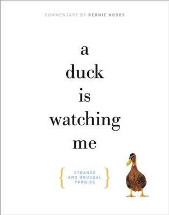A duck is watching me: strange and unusual phobias. Commentary by Bernie Hobbs

NLA Publishing, 2014. ISBN 9780642278647
(Age: 12+) Most people are aware of arachnophobia, the fear of
spiders, and claustrophobia, the fear of enclosed spaces. But what
about pupophobia, the fear of puppets, or lutraphobia, the fear of
otters? In A duck is watching me, photographs from the
collection of the National Library of Australia have been used to
raise awareness of a psychological condition that can be
debilitating to those affected.
The two page introduction by science writer and broadcaster Bernie
Hobbs is a textbook example of how scientific and medical knowledge
can be communicated to lay readers. After outlining the biology and
psychology of the fight-or-flight response, the author considers the
various origins of phobias including evidence that they can be
learned, inherited or develop after adverse experiences. She also
recommends programs organised by zoos to help those with phobias
about animals, and wisely advises anyone in the thrall of a phobia
to speak to a health professional. Bernie Hobbs has the ability to
convey information about a medical condition in a light-hearted
style that is enjoyable to read but maintains scientific credibility
and empathy for sufferers.
The book is neither a medical text book nor an in-depth study of the
causes and effects of phobias. Instead, readers can browse an
intriguing collection of nineteenth and twentieth-century
photographs, and dwell on the brief definition of the phobia with
which each picture is associated. For example, an 1890 portrait of a
child on a fur rug is matched with 'Doraphobia, the fear of fur' and
a photograph of spectators at the Sydney Cricket Ground in 1980
accompanies 'Demophobia, the fear of crowds'.
If the first step to overcoming a fear is to name it, then A duck is
watching me has certainly succeeded. Its playful approach to a
subject that is grounded in fear can help to promote an
understanding of the anxiety disorders that affect one in ten people
but are rarely discussed.
Elizabeth Bor